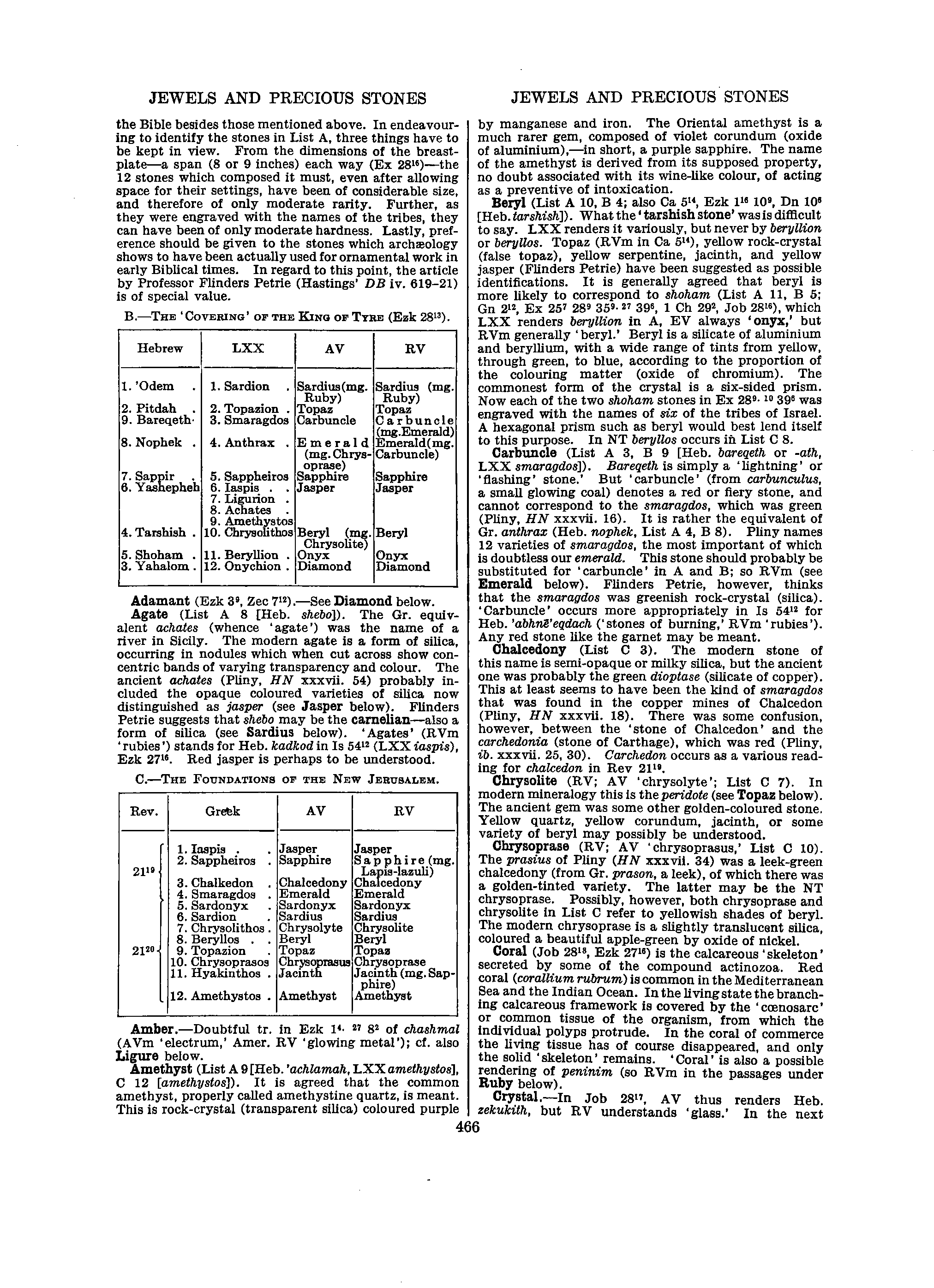JEWELS
AND
PRECIOUS
STONES
the
Bible
besides
those
mentioned
above.
In
endeavour-ing
to
identify
the
stones
in
List
A,
three
things
have
to
be
liept
in
view.
From
the
dimensions
of
the
breast-plate
—
a
span
(8
or
9
inches)
each
way
(Ex
28")
—
the
12
stones
which
composed
it
must,
even
after
allowing
space
for
their
settings,
have
been
of
considerable
size,
and
therefore
of
only
moderate
rarity.
Further,
as
they
were
engraved
with
the
names
of
the
tribes,
they
can
have
been
of
only
moderate
hardness.
Lastly,
pref-erence
should
be
given
to
the
stones
which
archeeology
shows
to
have
been
actually
used
for
ornamental
work
in
early
Biblical
times.
In
regard
to
this
point,
the
article
by
Professor
Flinders
Petrie
(Hastings'
DB
iv.
619-21)
is
of
special
value.
B.
—
The
'Covering'
or
the
Kino
of
Tyre
(Ezk
28^^),
Adamant
(Ezk
3',
Zee
7'^).
—
See
Diamond
below.
Agate
(List
A
8
[Heb.
shebd\).
The
Gr.
equiv-alent
achates
(whence
'agate')
was
the
name
of
a
river
in
Sicily.
The
modern
agate
is
a
form
of
silica,
occurring
in
nodules
which
when
out
across
show
con-centric
bands
of
varying
transparency
and
colour.
The
ancient
achates
(Pliny,
HN
xxxvii.
54)
probably
in-cluded
the
opaque
coloured
varieties
of
silica
now
distinguished
as
jasper
(see
Jasper
below).
Flinders
Petrie
suggests
that
shebo
may
be
the
camelian
—
also
a
form
of
sihca
(see
Sardius
below).
'Agates'
(RVm
'
rubies
')
stands
for
Heb.
kadkod
in
Is
5412
(LXX
iaspis),
Ezk
27".
Red
jasper
is
perhaps
to
be
understood.
Amber.
—
Doubtful
tr.
in
Ezk
!'■
"
8^
of
chashmal
(AVm
'electrum,'
Amer.
RV
'glowing
metal');
of.
also
Ligure
below.
Amethyst
(List
A
9
[Heb.
'achlamah,
LXX
amethystos],
C
12
[amethystos]).
It
is
agreed
that
the
common
amethyst,
properly
called
amethystine
quartz,
is
meant.
This
is
rock-crystal
(transparent
silica)
coloured
purple
JEWELS
AND
PRECIOUS
STONES
by
manganese
and
iron.
The
Oriental
amethyst
is
a
much
rarer
gem,
composed
of
violet
corundum
(oxide
of
aluminium),
—
in
short,
a
purple
sapphire.
The
name
of
the
amethyst
is
derived
from
its
supposed
property,
no
doubt
associated
with
its
wine-like
colour,
of
acting
as
a
preventive
of
intoxication.
Beryl
(List
A
10,
B
4;
also
Ca
5",
Ezk
1"
10',
Dn
10»
[Heb.
tarshish]).
What
the
'
tarshish
stone'
was
is
difficult
to
say.
LXX
renders
it
variously,
but
never
by
beryllion
or
beryllos.
Topaz
(RVm
in
Ca
5"),
yellow
rock-crystal
(false
topaz),
yellow
serpentine,
jacinth,
and
yellow
jasper
(Flinders
Petrie)
have
been
suggested
as
possible
identifications.
It
is
generally
agreed
that
beryl
is
more
likely
to
correspond
to
shoham
(List
A
11,
B
5;
Gn
212,
Ex
25'
28'
SS'-
"
39=,
1
Ch
29^
Job
28"),
which
LXX
renders
beryllion
in
A,
EV
always
'onyx,'
but
RVm
generally
'
beryl.'
Beryl
is
a
siUcate
of
aluminium
and
beryllium,
with
a
wide
range
of
tints
from
yellow,
through
green,
to
blue,
according
to
the
proportion
of
the
colouring
matter
(oxide
of
chromium).
The
commonest
form
of
the
crystal
is
a
six-sided
prism.
Now
each
of
the
two
shoham
stones
in
Ex
28»-
'°
39'
was
engraved
with
the
names
of
six
of
the
tribes
of
Israel.
A
hexagonal
prism
such
as
beryl
would
best
lend
itself
to
this
purpose.
In
NT
beryllos
occurs
in
List
C
8.
Carbuncle
(List
A
3,
B
9
[Heb.
bareqeth
or
-ath,
L.XX
smaragdos])
.
Bareqeth
is
simply
a,
'hghtning'
or
'flashing'
stone.'
But
'carbuncle'
(from
carlmnculus,
a
small
glowing
coal)
denotes
a
red
or
fiery
stone,
and
cannot
correspond
to
the
smaragdos,
which
was
green
(PUny,
HN
xxxvii.
16).
It
is
rather
the
equivalent
of
Gr.
anthrax
(Heb.
nophek.
List
A
4,
B
8).
PUny
names
12
varieties
of
smaragdos,
the
most
important
of
which
is
doubtless
our
emerald.
This
stone
should
probably
be
substituted
for
'carbuncle'
in
A
and
B;
so
RVm
(see
Emerald
below).
Flinders
Petrie,
however,
thinks
that
the
smaragdos
was
greenish
rock-crystal
(silica).
'Carbuncle'
occurs
more
appropriately
in
Is
6412
for
Heb.
'abhnS'egdach
('stones
of
burning,'
RVm
'rubies').
Any
red
stone
like
the
garnet
may
be
meant.
Chalcedony
(List
C
3).
The
modern
stone
of
this
name
is
semi-opaque
or
milky
silica,
but
the
ancient
one
was
probably
the
green
dioptase
(silicate
of
copper).
This
at
least
seems
to
have
been
the
kind
of
smaragdos
that
was
found
in
the
copper
mines
of
Chalcedon
(PUny,
HN
xxxvii.
18).
There
was
some
contusion,
however,
between
the
'stone
of
Chalcedon'
and
the
carchedonia
(stone
of
Carthage),
which
was
red
(PUny,
ib.
xxxvii.
25,
30).
Carchedon
occurs
as
a
various
read-ing
for
chalcedon
in
Eev
21".
Chrysolite
(RV;
AV
'chrysolyte';
List
C
7).
In
modern
mineralogy
this
is
the
peridote
(see
Topaz
below).
The
ancient
gem
was
some
other
golden-coloured
stone.
Yellow
quartz,
yellow
corundum,
jacinth,
or
some
variety
of
beryl
may
possibly
be
understood.
Chrysoprase
(RV;
AV
'chrysoprasus,'
List
C
10).
The
prasius
of
PUny
(HN
xxxvii.
34)
was
a
leek-green
chalcedony
(from
Gr.
prason,
a
leek),
of
which
there
was
a
golden-tinted
variety.
The
latter
may
be
the
NT
chrysoprase.
Possibly,
however,
both
chrysoprase
and
chrysoUte
in
List
C
refer
to
yeUowish
shades
of
beryl.
The
modern
chrysoprase
is
a
sUghtly
translucent
siUca,
coloured
a
beautiful
apple-green
by
oxide
of
nickel.
Coral
(Job
28",
Ezk
27'=)
is
the
calcareous
'skeleton'
secreted
by
some
of
the
compound
actinozoa.
Red
coral
(.corallium
rubrum)
is
common
in
the
Mediterranean
Sea
and
the
Indian
Ocean.
In
the
living
state
the
branch-ing
calcareous
framework
is
covered
by
the
'coenosarc'
or
common
tissue
of
the
organism,
from
which
the
individual
polyps
protrude.
In
the
coral
of
commerce
the
living
tissue
has
of
course
disappeared,
and
only
the
soUd
'skeleton'
remains.
'Coral'
is
also
a
possible
rendering
of
peninim
(so
RVm
in
the
passages
under
Ruby
below).
Crystal,—
In
Job
28",
AV
thus
renders
Heb.
zekukith,
but
RV
understands
'glass.'
In
the
next

